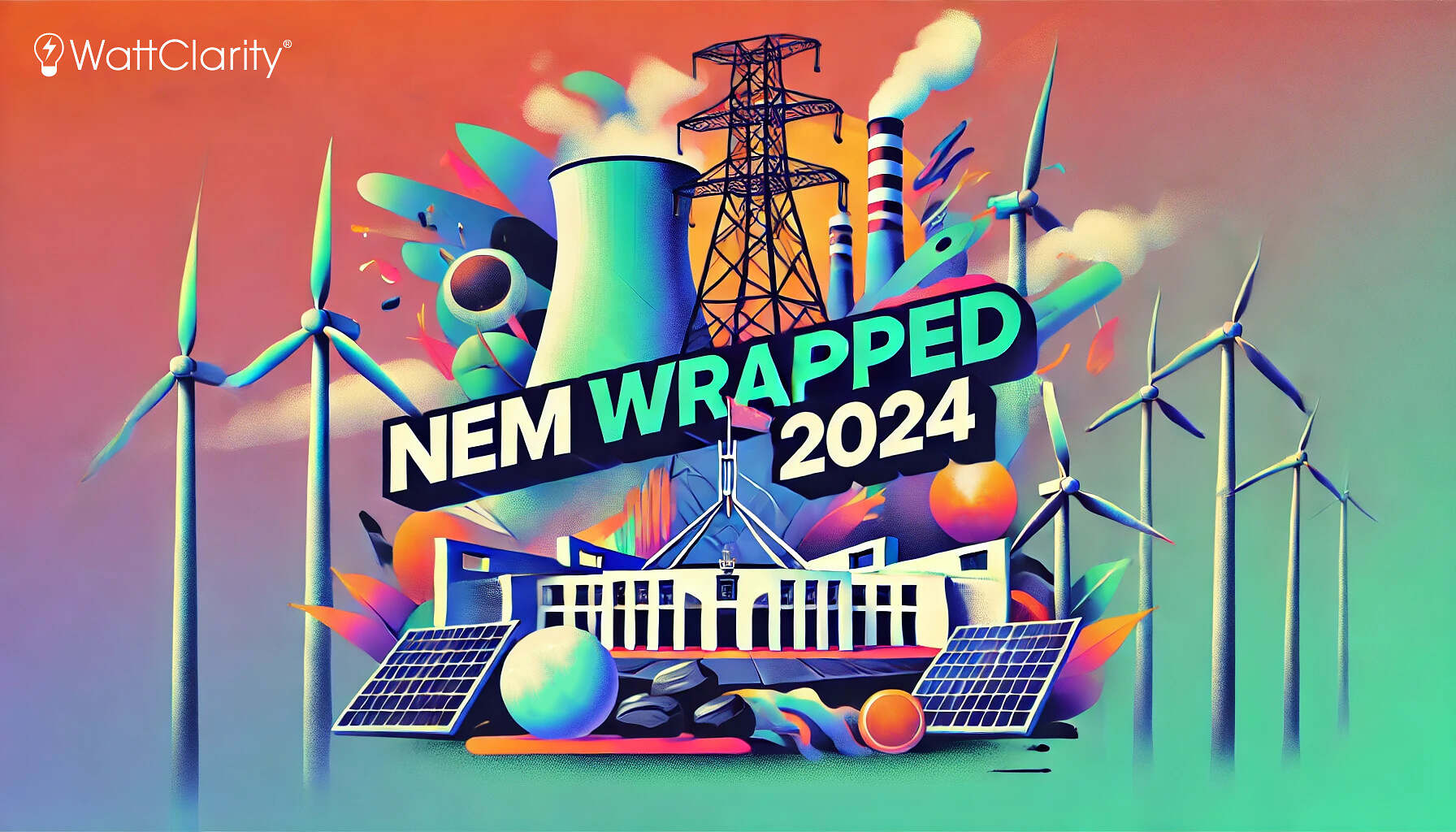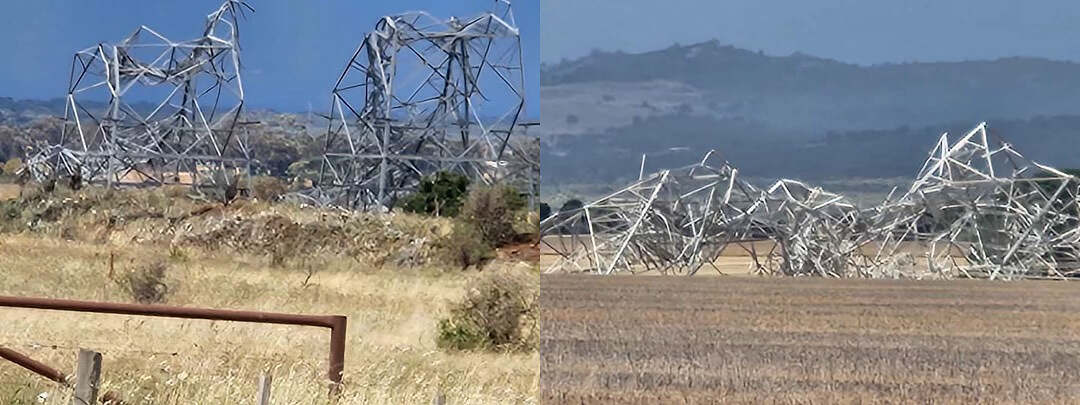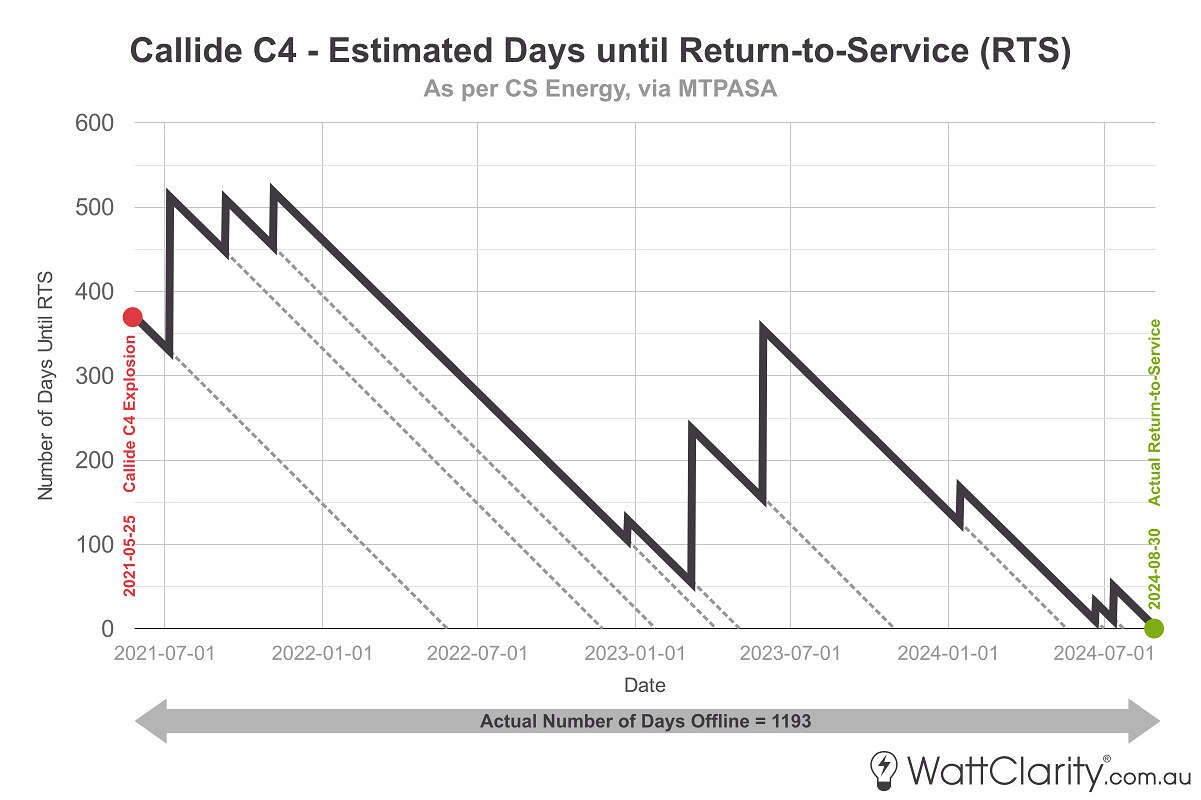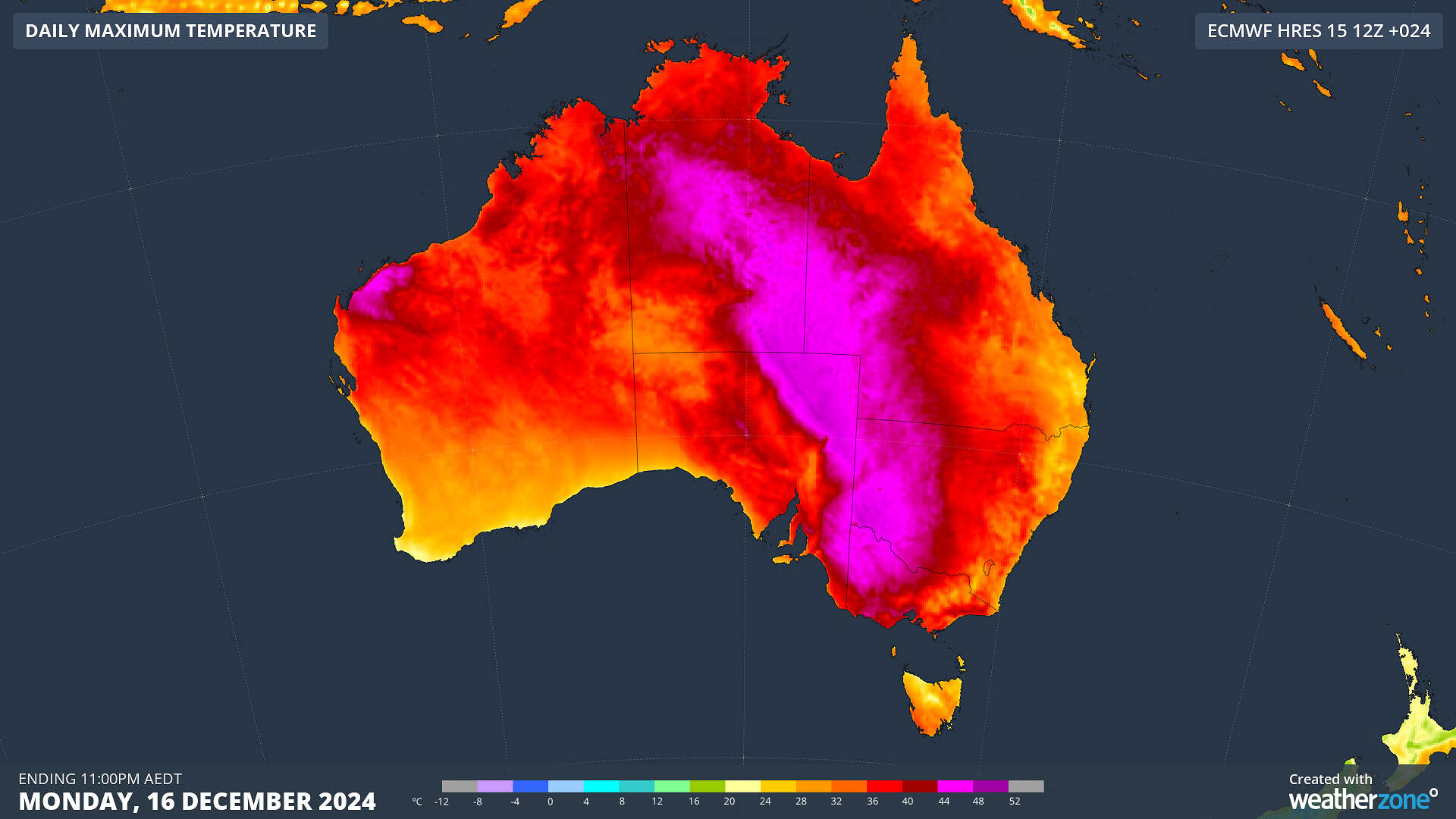2024 marked our 17th continuous year of operating WattClarity. Just like the NEM, we achieved numerous milestones and records in 2024, including all-time highs in web traffic, new subscribers, and the number of articles published.
With just a week remaining in the calendar year, we’ve so far managed to hit publish on 734 WattClarity articles this year. It’s likely you may have missed a few of these, so here’s my annual wrap-up of our WattClarity coverage to summarise what happened in the NEM in 2024.

Source: DALL-E
Year in Review
January began with a bang. On January 22nd, the NEM’s most northern region smashed its peak demand record, when market demand in Queensland exceeded 11,000 MW for the first time and surpassed the previous record by nearly 900 MW. The peak demand record coincided with temperatures in the state reaching the mid-to-high 40s.
In February, destructive storms in Victoria caused extensive damage to the transmission and distribution network, leading to power outages for hundreds of thousands of customers. Notably, six transmission towers collapsed north of Geelong due to severe winds, and all four units at Loy Yang A Power Station tripped during the incident. In unrelated but similarly devastating news, bushfires broke out a little over a week later, impacting Victoria, Tasmania, and New South Wales. Our forensic analysis suggested that smoke from those bushfires had a material impact on solar irradiance (and hence market demand) in Victoria.

Seven transmission towers were destroyed by severe winds in Victoria in February.
Compared to the previous month, March was relatively quiet in the NEM. It began with mainstream media headlines surrounding rumours of a possible extension to the life of Eraring Power Station (which was, at the time, scheduled to close in August 2025). On March 25th, an electrical fire broke out in the switchyard of Torrens Island Power Station, also impacting operations at the Torrens Island BESS.
Beginning in early April, the NEM experienced its worst ‘wind drought’ in almost seven years – with South Australia, Victoria, and New South Wales particularly affected.
In early May, a long run of extremely high spot prices in NSW forced Administered Pricing to come into effect for only the second time in history for the region, this eventually ended roughly one week later. On May 25th, an official announcement was made by the NSW Government and Origin Energy that Eraring Power Station’s retirement was being pushed back by 2-to-4 years. Meanwhile, the widespread wind drought that dogged the NEM in April continued for much of May, but in a short and unexpected reprieve, the final week of May resulted in the NEM reaching its highest instantaneous wind yield ever.
June was a turbulent month. In addition to the ongoing wind drought, drier-than-usual conditions also reduced hydro production, especially in Tasmania. As a result, the state’s Tamar Valley Gas Power Station got its first run in more than 5 years. Meanwhile, a number of compounding issues occurred within the east coast’s gas system – including a depletion of storage levels at Iona UGS, and low production at Longford – this led to the AEMO issuing a rare ‘Gas System Risk or Threat’ notice. The conflation of these factors impacting wind, hydro and gas generation contributed to Q2 electricity prices continuing on a long-term upward trajectory (as shown in the image below). Also in June, the Federal coalition announced a well-publicised pro-nuclear policy shift – and we even posted our very first (and maybe only ever) article on the topic of Nuclear power here on WattClarity.

Average prices bounced back higher for four of the five NEM regions in Q2 2024 compared to Q2 2023.
Source: NEMreview
In July, a significant climate-related record was apparently broken, then rescinded, when the ABC and BOM reported that a weather station in Sheffield, Tasmania recorded the highest-ever air pressure reading in Australia. A slight calculation error meant that the actual measurement (1,043.9 hPa) fell just short of the previous record by just 0.5 hPa. Later in July, we noted that the NEM saw a number of rare simultaneous price spikes in all regions.
Spring arrived early, with significant curtailment of VRE in the last week of August. We noted that two-thirds of the NEM’s large solar fleet was curtailed on the 24th of August. Also at the end of August, the AEMO released the 2024 edition of the ESOO with subdued press coverage compared to previous years – although Paul later noted that the order of presented results had changed from previous years. Also of note in August, Callide C4 finally returned to service after a 1,193-day outage following an explosion in the turbine hall in May 2021.

Callide C4’s expected return was delayed nine times, and eventually came after a 1,193-day outage.
Source: ez2view
In the first week of September, the market was briefly suspended in all regions due to IT issues at the AEMO. Paul noted a temporary drop in mainland system frequency coinciding with the market suspension. Also, as is now typical for Spring, curtailment levels reached extremes again with 75% of the large solar fleet curtailed in the middle of Sunday the 22nd of September.
October saw two major electricity system incidents occur within 24 hours. In NSW, seven transmission towers collapsed due to severe winds just south of Broken Hill – leaving the town islanded from the rest of the NEM for approximately two weeks. The next evening, twenty-nine transmission structures were destroyed in South Australia due to thunderstorms and strong winds, and also resulted in one of the state’s largest mines, Olympic Dam, losing power for almost a week.
In November, the Federal Government announced a new review into wholesale market reform, led by an independent panel chaired by Tim Nelson. In the last week of that month, supply tightness worries were experienced in NSW due to several power station outages coinciding with heatwave conditions, those conditions culminated on the 27th of November but thankfully reliability was maintained.

A heatwave across the mainland saw temperatures reach 47°C in Victoria for the first time in more than four years.
Source: WeatherZone
In December, the NEM experienced a surge in market demand, reaching a four-year high of 33,674 MW on December 16th, driven by extreme temperatures. During this time, temperatures in Victoria notably soared to 47°C for the first time since Black Summer. Meanwhile, in Queensland a major class action against Stanwell and CS Energy was dismissed by a Federal court. The case was the largest attempted class action against a generation owner in the history of the NEM. Later in December, the Federal Government announced 19 successful projects in the latest (and so far largest) round of the Capacity Investment Scheme.
Top 10 Most Read Articles
We don’t deliberately craft our content to maximise clicks, however, I think it is worth highlighting the articles that resonated most with our community of readers in 2024:
- Victorian power system event 13 Feb 2024 13:08 – a few quick notes by Allan O’Neil
- The early wind farms reaching 20 years: how are they performing? by Dan Lee
- Another tower collapse poses more questions about transmission by Dan Lee
- ‘Market Demand’ in South Australia falls to ‘lowest ever’ point on Saturday 19th October 2024 by Paul McArdle
- Towers down near Geelong on 13th February 2024 by Linton Corbet
- Solar Farms in south-western NSW constrained to 0MW on Monday 24th June 2024 by Paul McArdle
- 4 Loy Yang A units simultaneously trip, on Tuesday 13th February 2024 by Paul McArdle
- State-of-charge: a peek into the economics and performances within the NEM’s battery fleet by Dan Lee
- Convective downdrafts and high-voltage transmission lines by John Holmes
- Thar she blows! NSW hits the CPT and enters Administered Pricing (until Wed 15th May at least) … I think for only the 2nd time ever? by Paul McArdle
Top 10 Most Discussed Articles
Below are the top 10 articles from 2024 that received the most comments from readers on our site:
- Another tower collapse poses more questions about transmission by Dan Lee
- What is the point of the RRO? by Ben Skinner
- Optimising a highly renewable NEM from scratch by David Leitch
- Bruce Mountain’s commentary about Eraring is worth a read by Paul McArdle
- Need for speed: How long has each battery project in the NEM taken to deliver? by Dan Lee
- Where’s the wind gone, through 2024 Q2? … with June perhaps even worse than April or May! by Paul McArdle
- Updated trend of ‘ENERGY’ bids in red, green and blue by Paul McArdle
- Putting Monday’s record-breaking demand in QLD into context (22nd Jan 2024) by Dan Lee
- NEM-wide wind lull stretches extends to a full week (Tue 16th April 2024), and has another week to go! by Paul McArdle
- From the 4-second SCADA data, a view of Production by Fuel Type on Tuesday 13th February 2024 by Paul McArdle
WattClarity appearances in other media
From time to time, the analysis we publish on WattClarity gets referenced externally or republished by other media sources, and occasionally we are asked to provide direct commentary for journalists.
As we’ve done in previous years, Paul and I have kept track of external mentions and references that we’ve spotted. We do this so that we can share which pieces of our analysis were found to be of value to a wider audience (beyond this blog):
- ABC
- On May 26th, Paul provided direct quotes about high prices in NSW for an article by the ABC’s Daniel Mercer.
- On June 23rd, Paul’s article Where’s the wind gone, through 2024 Q2? was referenced by the ABC’s Stephen Letts.
- On June 24th, Paul’s article Where’s the wind gone, through 2024 Q2? was referenced in an interview with Tanya Plibersek by ABC Radio National host Patricia Karvelas.
- On August 29th, my article What the last twenty years of the ESOO tells us about blackout predictions was referenced by the ABC’s Daniel Mercer.
- On September 27th, Paul’s article Low, getting lower … AEMO’s forecasts for ‘Market Demand’ on Saturday 28th September 2024 was referenced by the ABC’s Daniel Mercer.
- The Guardian
- On October 12th, Paul’s article What happened with System Load in VIC on Friday 27th and Saturday 28th September 2024? was referenced by the Guardian’s Peter Hannam.
- On December 1st, my article NSW seemingly squeaked through yesterday was referenced by the Guardian’s Peter Hannam.
- Australian Financial Review
- On January 3rd, Allan’s article Out with a bang or a whimper? And a puzzle or two was referenced by the AFR’s Angela Macdonald-Smith.
- On January 4th, Paul’s article What’s running in Victoria today (apart from strong rooftop PV)? was referenced by the AFR’s Angela Macdonald-Smith.
- On February 5th, Paul’s article NEM-wide ‘Market Demand’ reached 32,938MW on Sunday 4th Feb 2024 was referenced by the AFR’s Angela Macdonald-Smith.
- On March 1st, Paul’s article So how much did Eraring Power Station supply, of the NSW electricity consumption, at peak demand time on Thursday 29th February 2024? was referenced by the AFR’s Angela Macdonald-Smith.
- On June 20th, Paul’s article More detail on the poor wind yield through (most of!) April and May 2024 was referenced by the AFR’s Angela Macdonald-Smith and Gus McCubbing.
- On June 24th, Paul’s article Where’s the wind gone, through 2024 Q2? was referenced by AFR’s Angela Macdonald-Smith.
- On September 2nd, Paul’s article Curtailment (spillage) of Large Solar reaches 2/3 of total resource, on Saturday 24th August 2024 was referenced by the AFR’s Angela Macdonald-Smith.
- The Age
- On February 16th, my article Another tower collapse poses more questions about transmission was referenced by the Age reporters Josh Gordon, Kieran Rooney and Broede Carmody.
- On February 29th, Allan’s article Out with a bang or a whimper? And a puzzle or two was referenced by Age reporter Kieran Rooney.
- The Australian
- On June 23rd, Paul’s article Where’s the wind gone, through 2024 Q2? was referenced by the Australian’s Perry Williams and Rhiannon Down.
- On November 29th, my article Which units are still offline in NSW and QLD, as of 3:30pm on 27th Nov 2024 was referenced by Aiden Morrison in the Australian.
- RenewEconomy
- On January 11th, RenewEconomy republished my article The early wind farms reaching 20 years: how are they performing?.
- On February 22nd, my article Another tower collapse poses more questions about transmission was referenced by David Leitch on the RenewEconomy Energy Insiders Podcast.
- On March 7th, RenewEconomy republished my article State-of-charge: a peek into the economics and performances within the NEM’s battery fleet
- On April 17th, Paul’s article NEM-wide wind lull stretches extends to a full week, and has another week to go! was referenced by RenewEconomy’s Giles Parkinson.
- On May 2nd, RenewEconomy republished my article Keeping Up with the Curtailment Part 2: The what and the where
- On June 7th, RenewEconomy republished my article Who’s who in the ESOO
- On August 30th, Paul’s article Curtailment (spillage) of Large Solar reaches 2/3 of total resource, on Saturday 24th August 2024 was referenced by David Leitch on the RenewEconomy Energy Insiders Podcast.
- On October 20th, Paul’s article NEM-wide ‘Market Demand’, falls below 10,000MW for the first time ever* was referenced by RenewEconomy’s Giles Parkinson
- PV Magazine
- On March 8th, PV Magazine republished my article State-of-charge: a peek into the economics and performances within the NEM’s battery fleet
- On May 6th, PV Magazine republished my article Keeping Up with the Curtailment Part 2: The what and the where
- On August 8th, PV Magazine republished my article What the last twenty years of the ESOO tells us about blackout predictions
- Other
- On January 1st, Paul’s article AEMO released draft of 2024 Integrated System Plan … cue the media headlines was referenced in the Coolbah’s Consulting Monthly Issue by Keith Orchison.
- On January 19th, Allan’s article Out with a bang or a whimper? And a puzzle or two was referenced in a report by Climate Energy Finance’s Tim Buckley.
- On January 25th, my article Putting Monday’s record-breaking demand in QLD into context was included in Endgame Analytics’ Weekly Dispatch.
- On March 12th, Tristan’s article Four reasons why rooftop solar will grow to dominate the electricity market was referenced by the New Matilda’s Geoff Russell.
- On July 4th, my article A running view of the recent wind drought was referenced by the Australian Energy Council’s Carl Kitchen and Tom Monaghan.
- On August 27th, my article What the last twenty years of the ESOO tells us about blackout predictions was referenced by climate change blogger Ketan Joshi.
- On September 22nd, WattClarity received a mention from the Australian Institute’s Matt Saunders.
- On November 24th, Paul’s article Eraring Unit 2 makes it back online, Saturday evening 25th May 2024 was referenced by the NSW Government in their annual electricity retail pricing report.
- On November 25th, Paul’s article Forecast load shedding (i.e. LOR3) in NSW on Wednesday 27th November 2024 above 1,700 but now easing? was referenced in an Instagram post by Senator Malcolm Roberts.
- On December 5th, Senator Matt Canavan referenced WattClarity when questioning AEMO’s Daniel Westerman in a Senate Committee Hearing.
Guest Authored Posts
In 2024, we published or republished 48 guest-authored articles from 24 different guest authors. These authors came from a wide range of backgrounds, including analysts, economists, meteorologists, engineers, and lawyers.
I’d like to extend a big thank you to the following individuals for their guest-authored contributions to WattClarity throughout 2024. You can click on their names to read their articles:
- Allan O’Neil – independent electricity market analyst and consultant.
- Ben Skinner – policy analyst, electrical engineer and former trader, currently at AEMO.
- David Leitch – financial analyst specialising in utilities, currently Principal at ITK Services.
- Tristan Edis – analyst and advisor, currently at Green Energy Markets.
- Ben Domensino, meteorologist, currently at WeatherZone.
- Oliver Nunn – economist and mathematician, currently the Managing Director at Endgame Analytics.
- Carl Daley – energy market analyst, currently at SavvyPlus and Empower Analytics.
- Greg Williams – economist and policy advisor, currently at ARENA.
- Mitch Baker – project development specialist, currently at RES.
- Geoff Eldridge – advisor and energy analyst, currently at Global Power Energy.
- Dr John Holmes – structural engineer and wind loading expert, currently the Managing Director at JDH Consulting.
- Dr Roger Dargaville – lecturer and professor, currently at Monash University.
- Nick Bartels – electricity market analyst and former trader, currently at Greenview Strategic Consulting.
- James Tetlow, current CEO of Overwatch Energy.
- Ellise Janetzki, operations manager at Overwatch Energy.
- Alex Leemon, electricity market specialist at GridCog.
- Pan Galanis, director and energy market specialist, currently at Akaysha Energy.
- Philippe Orhan, project manager and engineer, currently at Neoen.
- Connor James, lawyer and compliance specialist, at Compliance Quarter.
- Ant Sharwood, journalist, currently at WeatherZone.
- Warwick Forster, director and former trader, currently the Managing Director at Apogee Energy.
- Anthony Cornelius, meteorologist, currently the Managing Director at WeatherWatch.
- Ashleigh Madden, meteorologist at WeatherZone.
- James Prest, energy and climate lawyer, currently at Environmental and Energy Law Advisory.
- Paul Bandarian, independent energy analyst and market modeller.
Happy holidays and all the best for 2025
From myself, Paul, Linton, Adam, and the rest of the Global-Roam team, I wish everyone in our community a very Merry Christmas and a Happy New Year. We thank you for your readership and support throughout 2024, and we wish you all the best for the new year ahead.


Leave a comment